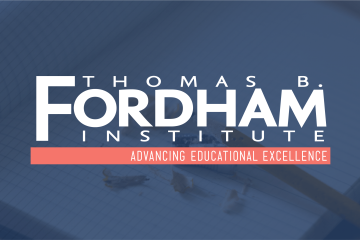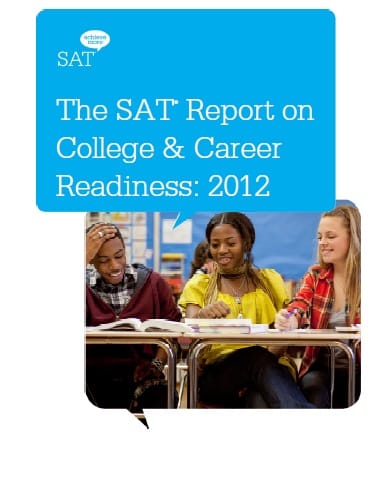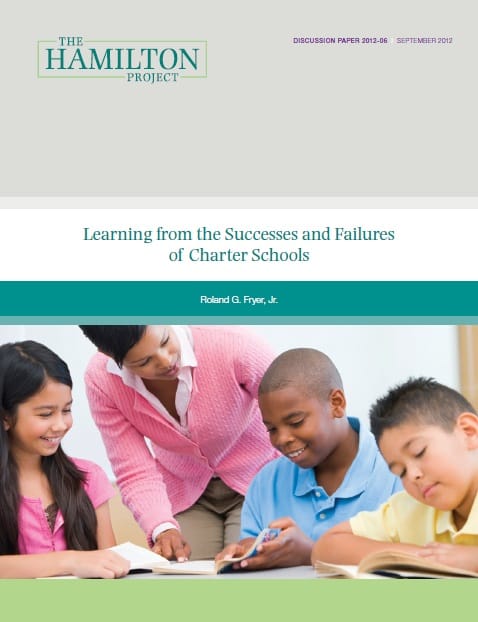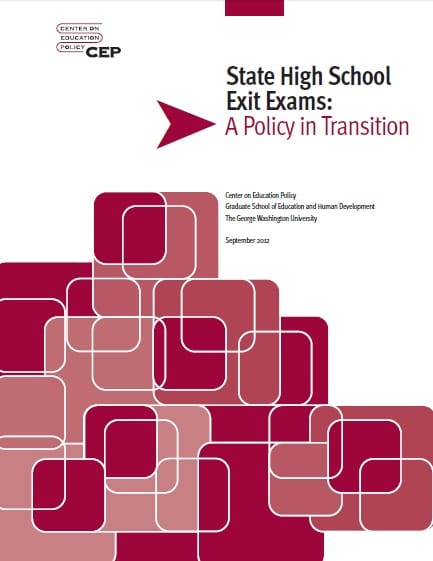
The SAT Report on College and Career Readiness: 2012
More and less

More and less











 Two main takeaways emerge from this latest College Board report on the most recent SAT scores: 1) Participation rates are at an all-time high; and 2) as more adolescents sit for the three-hour exam, average scores decline. First, a bit about participation rates: This past spring, roughly 1.66 million students took the SAT, about 52 percent of the Class of 2012 and 6 percent more than in 2008. Of that number, 45 percent were minority students (up from 38 percent in 2008). Twenty-eight percent reported that English was not their exclusive first language (up four percentage points from 2008). And 36 percent reported that their parents’ highest level of education was a high school diploma or less. In sum, the 2012 testing cohort was the College Board’s most diverse to date. That’s the good news. Now for the scores. (Recall that there are now three parts of the SAT: To the traditional critical reading and mathematics sections, College Board added a writing section that was first tallied in 2006. Each section is scored from 200 to 800, with a perfect score [obviously] of 2400.) The mean subject scores this time around were 496 in critical reading (down four points from 2008—and down a whopping thirty-four points from 1972), 514 in math (consistent since 2008 but down from a peak of 520 in 2005), and 488 in writing (down five points from its peak in 2008). Overall, the proportion of test takers whom the College Board deems reasonably prepared for college—based on combined SAT score—leveled at 43 percent in both 2011 and 2012, leaving a majority of those who presumably aspire to attend four-year colleges ill-prepared to succeed there. Not surprisingly, youths who report completing a core curriculum (four-plus years of high school English, and three-plus years of math, social studies, and science) fare better on the SAT than those who did not. (So did those enrolled in AP courses and those with college-educated parents.) The authors indicate that the College Board is “committed to building deeper alignment” between the SAT and the Common Core—which might have long-term repercussions for the test, and for those in the forty-six CCSS adoptor states who are committed to taking it. In any case, here’s further evidence of a big hole in our K-12 universe.
Two main takeaways emerge from this latest College Board report on the most recent SAT scores: 1) Participation rates are at an all-time high; and 2) as more adolescents sit for the three-hour exam, average scores decline. First, a bit about participation rates: This past spring, roughly 1.66 million students took the SAT, about 52 percent of the Class of 2012 and 6 percent more than in 2008. Of that number, 45 percent were minority students (up from 38 percent in 2008). Twenty-eight percent reported that English was not their exclusive first language (up four percentage points from 2008). And 36 percent reported that their parents’ highest level of education was a high school diploma or less. In sum, the 2012 testing cohort was the College Board’s most diverse to date. That’s the good news. Now for the scores. (Recall that there are now three parts of the SAT: To the traditional critical reading and mathematics sections, College Board added a writing section that was first tallied in 2006. Each section is scored from 200 to 800, with a perfect score [obviously] of 2400.) The mean subject scores this time around were 496 in critical reading (down four points from 2008—and down a whopping thirty-four points from 1972), 514 in math (consistent since 2008 but down from a peak of 520 in 2005), and 488 in writing (down five points from its peak in 2008). Overall, the proportion of test takers whom the College Board deems reasonably prepared for college—based on combined SAT score—leveled at 43 percent in both 2011 and 2012, leaving a majority of those who presumably aspire to attend four-year colleges ill-prepared to succeed there. Not surprisingly, youths who report completing a core curriculum (four-plus years of high school English, and three-plus years of math, social studies, and science) fare better on the SAT than those who did not. (So did those enrolled in AP courses and those with college-educated parents.) The authors indicate that the College Board is “committed to building deeper alignment” between the SAT and the Common Core—which might have long-term repercussions for the test, and for those in the forty-six CCSS adoptor states who are committed to taking it. In any case, here’s further evidence of a big hole in our K-12 universe.
SOURCE: The College Board, The SAT Report on College and Career Readiness: 2012 (New York, NY: The College Board, September 2012).

 Charter schools—“exceedingly rare laboratories” for educational innovation—have much to teach the traditional district sector, explains Harvard economist cum MacArthur “genius” awardee Roland Fryer in this paper for the Brookings Institution’s Hamilton Project. Drawing upon his recent evaluation of charter schools in New York City, Fryer offers five educational practices that explain nearly half of the achievement difference between high- and low-performing charters: 1) a focus on human capital (weekly teacher-development sessions, for example); 2) the use of data to drive (and personalize) instruction; 3) the provision of high-dosage tutoring (targeted based on data-driven analyses); 4) the extension of time on task (by lengthening the school day and year); and 5) the establishment of a high-expectations culture. Profiling Houston and Denver, Fryer then explains how this package of reforms may be brought to scale—and what the marginal cost for implementing each would be. Overall, Fryer estimates a $6 billion price tag to avail the 3 million students in the nation’s 5,000 lowest-performing district schools of this reform package. Though this sticker price may be negotiable. For example, Fryer’s budget doesn’t address how technology could be exploited to lower long-term costs (think: tutoring). And, as he asserts in the paper: “While costs may vary by school, one thing is clear: High expectations are free.”
Charter schools—“exceedingly rare laboratories” for educational innovation—have much to teach the traditional district sector, explains Harvard economist cum MacArthur “genius” awardee Roland Fryer in this paper for the Brookings Institution’s Hamilton Project. Drawing upon his recent evaluation of charter schools in New York City, Fryer offers five educational practices that explain nearly half of the achievement difference between high- and low-performing charters: 1) a focus on human capital (weekly teacher-development sessions, for example); 2) the use of data to drive (and personalize) instruction; 3) the provision of high-dosage tutoring (targeted based on data-driven analyses); 4) the extension of time on task (by lengthening the school day and year); and 5) the establishment of a high-expectations culture. Profiling Houston and Denver, Fryer then explains how this package of reforms may be brought to scale—and what the marginal cost for implementing each would be. Overall, Fryer estimates a $6 billion price tag to avail the 3 million students in the nation’s 5,000 lowest-performing district schools of this reform package. Though this sticker price may be negotiable. For example, Fryer’s budget doesn’t address how technology could be exploited to lower long-term costs (think: tutoring). And, as he asserts in the paper: “While costs may vary by school, one thing is clear: High expectations are free.”
SOURCE: Roland G. Fryer, Jr. Learning from the Successes and Failures of Charter Schools (Washington, D.C.: Hamilton Project at the Brookings Institution, September 2012).

 Common Core implementation portends vast, intimidating changes in the ways we manage American K-12 education. Included in these shifts are the handling of promotion and graduation requirements and assessments. This Center on Education Policy report—the organization’s eleventh annual look at high school exit exams—offers a glimpse of how states are currently tackling these issues at the secondary level. Twenty-five states administer high school exit exams, be they comprehensive (assessing multiple subjects at the end of a given grade, usually tenth) or end-of-course, which are gaining popularity. These states house nearly 70 percent of American high schoolers, and even higher percentages of disadvantaged youth. While all of them allow retakes (up to a dozen in Maryland and Oregon), the vast majority of students (70-90 percent) pass their exit exams on the first go-around. Yet most states with exit exams do not align them to career-and-college-ready standards (and only one state—Nevada—aligns its exam to content taught through the twelfth grade). This will have heavy implications for CCSS roll-out as eighteen states plan to align their exit exams to the Common Core—or replace their current assessments with those developed by PARCC and SBAC. Gadfly is wagering that very few states will actually tie high school graduation to a proficiency score on the Common Core assessments—not, at least, if “proficiency” is defined as true college readiness. The failure rates will simply be too high. Ironically, then, the Common Core standards could end up killing exit exams as we know them.
Common Core implementation portends vast, intimidating changes in the ways we manage American K-12 education. Included in these shifts are the handling of promotion and graduation requirements and assessments. This Center on Education Policy report—the organization’s eleventh annual look at high school exit exams—offers a glimpse of how states are currently tackling these issues at the secondary level. Twenty-five states administer high school exit exams, be they comprehensive (assessing multiple subjects at the end of a given grade, usually tenth) or end-of-course, which are gaining popularity. These states house nearly 70 percent of American high schoolers, and even higher percentages of disadvantaged youth. While all of them allow retakes (up to a dozen in Maryland and Oregon), the vast majority of students (70-90 percent) pass their exit exams on the first go-around. Yet most states with exit exams do not align them to career-and-college-ready standards (and only one state—Nevada—aligns its exam to content taught through the twelfth grade). This will have heavy implications for CCSS roll-out as eighteen states plan to align their exit exams to the Common Core—or replace their current assessments with those developed by PARCC and SBAC. Gadfly is wagering that very few states will actually tie high school graduation to a proficiency score on the Common Core assessments—not, at least, if “proficiency” is defined as true college readiness. The failure rates will simply be too high. Ironically, then, the Common Core standards could end up killing exit exams as we know them.
SOURCE: Center on Education Policy, State High School Exit Exams: A Policy in Transition (Washington, D.C.: George Washington University Graduate School of Education and Human Development, September 2012).

Mike and Dara analyze the NAACP’s definition of discrimination and grapple with the unpleasant reality that Ohio’s online schools mostly suck. Amber looks at what it takes to exit high school these days.
Center on Education Policy, State High School Exit Exams: A Policy in Transition (Washington, D.C.: George Washington University Graduate School of Education and Human Development, September 2012)

The NAACP Legal Defense Fund filed a federal civil-rights complaint against the New York City Department of Education last week on grounds that the special test used for admission to eight of the city's selective public high schools is discriminatory—because it results in too few African American and Hispanic youngsters gaining entry into those schools.
The Specialized High Schools Admission Test (SHSAT) is a two-hour multiple-choice exam. Under a forty-year-old state law, the scores that students earn on it—and only those scores—determine who gets into, and rejected by, these eight schools, including the three old and famous ones: Stuyvesant, Bronx Science, and Brooklyn Tech.
The SHSAT is also a very big deal in New York City, as some 28,000 (mostly) eighth and ninth graders take it every year, competing for about 6,000 spaces in the schools themselves. Because attending any of these schools is a pretty certain path to graduation and admission into a decent (or even stellar) university, all at public expense, the competition is fierce. There are cram schools and tutors. And one's test score determines everything.
That's rare in the world of selective-admission public high schools, as Jessica Hockett and I learned in our recent examination of some 165 such schools around the country. Nearly all the others consider multiple elements of their applicants' readiness to do well in the generally high-powered academic environments that such schools offer. Along with test results, they weigh middle school grades, teacher recommendations, essays, even interviews, much like the admissions offices of selective colleges.
That's the case with dozens of other "screened" high schools in New York, too, which are selective—often highly so—but don't rely exclusively on a single test score to decide who gets in. (We profile one such school, Townsend Harris High School, in the book.)
The NAACP’s civil-rights complaint is based on what's known nowadays as "disparate-impact analysis," which is to say that if a seemingly objective and even-handed procedure yields a result that is not equitably distributed by race (or gender, handicapping condition, whatever), it is presumed to be discriminatory on grounds forbidden under sundry civil-rights laws and constitutional provisions.
Because black and Hispanic youngsters are indeed "underrepresented" in the entering classes of the SHSAT high schools when compared with the youth demographics of New York City—and there's no denying that they are, just as white and especially Asian youngsters are "overrepresented"—the NAACP asserts that the test must be discriminatory and therefore the federal Office for Civil Rights should make the city stop using it.
Such a holding would, in effect, suspend a four-decades-old state law and there is little doubt that litigation would follow—even as the U.S. Supreme Court is once again weighing whether race can be used as a factor in university admissions.
My co-author agrees with the NAACP that New York should stop using the SHSAT as the exclusive basis for high school admission. I agree with her that a more "holistic" evaluation of applicants for admission to those eight schools is educationally desirable. I also believe that New York City could and should be doing a vastly better job of identifying high-potential kids at an early age and affording them educational opportunities that would better equip them to compete successfully for entry into schools like Stuyvesant. But I don't have much patience for disparate-impact analysis or for the effort to enlist the feds to force New York to stop doing something that the state legislature required it to do and that the city’s mayor, who runs the schools, believes is fair.
RELATED ARTICLE: “Charges of Bias in Admission Test Policy at Eight Elite Public High Schools,” by Al Baker, New York Times, September 27, 2012.

Next month, Georgia voters will head to the polls to decide whether their state can establish an independent commission to authorize and oversee some of its charter schools. Such a panel once existed in the Peach State and authorized sixteen schools before the state Supreme Court voted 4-3 last year to dissolve it on grounds that it was “palpably unconstitutional.” The original commission had authorized charters over the objections of local school boards, which brought the suit against the state and which remain the most fervent opponents of the current referendum. (Districts, of course, would compete with the schools operating under the commission’s direction.)
Unfortunately, the press and interest groups are largely on the school boards’ side, bemoaning the potential loss of “local control” and the prospect that the state would authorize schools unanswerable to local communities. According to a pre-election poll, however, at least half of Georgia’s voters appear to feel differently. Not surprising, considering that twenty years of charter schooling have highlighted the dysfunction of Georgia-style “local control” and the extent to which school boards and superintendents will go to preserve their near-monopolies. Ten other states have independent panels of this sort to authorize charter schools, precisely so that promising charter providers don’t have to depend on the whims of recalcitrant school boards. Georgia should rejoin them.

 Parent-trigger paean Won't Back Down opened with a whimper last weekend, grossing a measly $2.6 million despite the hoopla surrounding it. Whether the movie is thought-provoking or snooze-inducing, it will be about as transformative as the parent trigger itself has been if no one sees it.
Parent-trigger paean Won't Back Down opened with a whimper last weekend, grossing a measly $2.6 million despite the hoopla surrounding it. Whether the movie is thought-provoking or snooze-inducing, it will be about as transformative as the parent trigger itself has been if no one sees it.
Jay Mathews was correct to point out on Sunday that education reformers regularly contradict themselves by backing prescriptive teacher evaluation for district public schools while advocating for greater autonomy for charter schools.
There's still plenty of bickering left to do over who won and lost the Chicago teachers' strike, but the school system's long-term financial flexibility is squarely in the loss column after Moody's downgraded the Board of Education's credit rating. How long before teacher unions realize that securing unaffordable benefits only guarantees more cost-cutting, acrimony, and bitterness in the future?
Mitt Romney clarified one part of his budget plans in striking fashion at last night's presidential debate, promising not to cut education spending if elected. If the GOP candidate can pull off the upset next month, he may find this remark makes his spending policies far more complicated come 2013.
Congrats to value-added guru Raj Chetty for his new MacArthur “genius” award. Unfortunately, existing value-added metrics require a bit more refinement before anyone receives a Gadfly “genius” award (and the accompanying $500,000 podcast subscription).
Despite all the Page Six rumors, Gadfly can neither confirm nor deny that an all-star analyst will be debuting (again?) on Flypaper next Monday. But be warned, Secretary Duncan, Race to the Top’s holiday from analysis and excoriation on Fordham’s blogs looks to be over.

Last week, the Policy Innovators in Education (PIE) Network brought together its member organizations for its annual confab, this year in Minneapolis. State-based school-reform-advocacy groups gathered with five national policy partners (Fordham included) to talk shop about our work to improve America’s schools.
Among the discussions about policy, strategy, tactics, and lessons learned (especially from Chicago), the most fascinating—and perhaps significant—conversation was about the school-reform agenda itself. What’s currently consuming the education-reform movement? What’s next up on the to-do list? And what potentially game-changing item is on the horizon? Allow me to report.
 What's on the horizon for education reform ? Photo by Thelonius58. |
The first point (and perhaps an obvious one) is that reformers nationwide are deep in implementation mode. Thanks to huge state-level policy victories on common standards, teacher evaluations, school choice, and more (some of it inspired by the federal Race to the Top program), much focus has shifted to getting stuff done at the local level. That’s led some to call for a breather when it comes to new legislative activity. Like a snake that’s just swallowed a deer, most reformers (and the education system itself) simply can’t take anything else on right now.
But that’s not the case everywhere. In some states, the 2013 legislative session is likely to feature big fights around:
Let’s take each in turn.
This focus is a natural outgrowth of reformers’ obsession with teacher evaluations and with the demands of Common Core implementation. It’s also inspired by the National Council on Teacher Quality’s national review of education schools, due for release next spring. Simply put, now that serious efforts are underway to gauge teacher effectiveness and upgrade instructional skills to prepare for higher standards, doesn’t it make sense to improve teacher quality at the source? In a rational world, this battle would have been joined years ago. But the ed schools are famously resistant to change; NCTQ and many state organizations are hopeful that this time might be different. Reformers want states to raise standards for entry into teacher-prep programs; forcing them to educate in research-based methods for teaching reading; align their curriculum with the Common Core; develop data systems that can link student-achievement results to teachers’ preparation programs; and shut down the many mediocre (or worse) ed schools in operation today.
One clever session at the PIE Network conference asked, “Are principals the new teachers?” Expect reformers to do to school leaders what they’ve done to teachers: Develop more rigorous evaluation systems; open up alternate routes into the profession; offer differential pay for tough assignments or exceptional performance; etc.
States have already been busy on this front, but mostly with an eye toward closing big holes in their pension obligations, not in fundamentally reforming the system. In many cases, these changes have made problems worse from a teachers' labor-market perspective. In changing the system, state leaders have lowered new teachers’ take-home pay by mandating exorbitant contribution rates; they’ve refused to offer 401(k) style options because they need new teachers’ dollars to finance current obligations to retirees (see Webster’s definition of a Ponzi Scheme); and they’ve made teaching less attractive by reducing benefits in the long term. In other words, they’ve held today’s retirees (and older teachers) harmless while putting the burden of “reform” on new teachers and those still in ed school. (The Baby Boomers strike again.) Reformers will work for more fundamental, sustainable fixes.
With the support of Digital Learning Now! and former governors Jeb Bush and Bob Wise, advocates in many states will be pushing to eliminate “seat time” requirements; create or expand online charter schools; and tweak teacher-evaluation systems to deal with the rise of hybrid learning environments (which often move away from the one “teacher of record” model).
Those issues aren’t exactly small potatoes; each could stake a claim to having “transformative” potential: Upgrading our teacher and leader pipelines could make American schools more like the best systems in the world; moving toward portable pension systems would make it vastly easier to terminate ineffective teachers (if hundreds of thousands of dollars of pension wealth is no longer at stake); digital learning is undoubtedly going to play a significant role in the schools of tomorrow.
But there’s an issue on the horizon that could potentially trump all of that, for it touches every piece of the education enterprise: school finance. While this item isn’t exactly “new,” a new approach could revolutionize our schools.
Arguably the last time a state upended its fundamental approach to school finance was Michigan in 1993, under the leadership of then-Governor John Engler. The legislature eliminated local property taxes as a source for school funding, voters approved an increase in the statewide sales tax, and the burden of education finance shifted significantly away from districts and to Lansing. This made education spending in Michigan much more equitable, and also set the stage for an explosion of public school choice—not just via charter schools but via the inter-district variety as well. Now 115,000 students in Michigan participate in public school choice through charter schools alone, facilitated by the state dollars that follow them to the venue of their choice.
 How far are we from the Holy Grail of school-finance reform? Photo by Eddi van W.. |
Twenty years later, are we ready to take the next step? The Holy Grail, according to many reformers, is to shift school finance entirely to the state level. That may prove politically impossible (affluent districts are always going to want to retain the right to tax themselves at higher rates in order to exceed average spending). But one could imagine a savvy governor calling for significant property-tax relief at the local level, to be offset by new taxes at the state level. Then, funds would flow back to the schools (stress “schools”—not school districts) via student-based budgeting. In other words: in the kids’ “backpacks,” following them to the schools of their choice, with needy kids carrying more dollars than their peers.
Such changes would have a catalytic effect on the larger reform movement. Educational choice would thrive, with charter schools earning a fairer share of funding and course-level financing for digital learning becoming much more doable. (In states with school vouchers, private school choice would flourish too.) Equity would be promoted, with poor districts much more able to offer competitive salaries, extended learning time, and early interventions than they are today. School principals would be empowered to spend their dollars strategically, and to hire the best teachers they can afford. Districts would no longer be able to micromanage schools, as they wouldn’t control the purse strings. And the stranglehold of “local control” would be further diminished, as the state picks up the tab for an enterprise in which it increasingly calls the shots.
This brand of school-finance reform, some say, is political suicide. Perhaps. But if there’s a way to a “Grand Bargain” on education funding, the savvy advocacy groups of the PIE Network will find it. Stay tuned.

The Common Core is coming, with forty-five states and the District of Columbia challenged to implement these new standards. Yet mystery surrounds how much this will cost states (and districts)—and whether the payoff will justify the price.
On May 30, the Fordham Institute will peek behind that curtain with a lively panel discussion of "Pricing the Common Core." Taking part will be former Florida Education Commissioner Eric J. Smith, Achieve President Mike Cohen, former Department of Education official Ze'ev Wurman, and University of San Francisco professor Patrick J. Murphy, who will present the findings of a new Fordham study that he co-authored. It estimates the dollar cost of the implementation process for each participating state—and shows how the pricetag varies depending on the approach a state selects.

The Common Core is coming, with forty-five states and the District of Columbia challenged to implement these new standards. Yet mystery surrounds how much this will cost states (and districts)—and whether the payoff will justify the price.
On May 30, the Fordham Institute will peek behind that curtain with a lively panel discussion of "Pricing the Common Core." Taking part will be former Florida Education Commissioner Eric J. Smith, Achieve President Mike Cohen, former Department of Education official Ze'ev Wurman, and University of San Francisco professor Patrick J. Murphy, who will present the findings of a new Fordham study that he co-authored. It estimates the dollar cost of the implementation process for each participating state—and shows how the pricetag varies depending on the approach a state selects.

 Two main takeaways emerge from this latest College Board report on the most recent SAT scores: 1) Participation rates are at an all-time high; and 2) as more adolescents sit for the three-hour exam, average scores decline. First, a bit about participation rates: This past spring, roughly 1.66 million students took the SAT, about 52 percent of the Class of 2012 and 6 percent more than in 2008. Of that number, 45 percent were minority students (up from 38 percent in 2008). Twenty-eight percent reported that English was not their exclusive first language (up four percentage points from 2008). And 36 percent reported that their parents’ highest level of education was a high school diploma or less. In sum, the 2012 testing cohort was the College Board’s most diverse to date. That’s the good news. Now for the scores. (Recall that there are now three parts of the SAT: To the traditional critical reading and mathematics sections, College Board added a writing section that was first tallied in 2006. Each section is scored from 200 to 800, with a perfect score [obviously] of 2400.) The mean subject scores this time around were 496 in critical reading (down four points from 2008—and down a whopping thirty-four points from 1972), 514 in math (consistent since 2008 but down from a peak of 520 in 2005), and 488 in writing (down five points from its peak in 2008). Overall, the proportion of test takers whom the College Board deems reasonably prepared for college—based on combined SAT score—leveled at 43 percent in both 2011 and 2012, leaving a majority of those who presumably aspire to attend four-year colleges ill-prepared to succeed there. Not surprisingly, youths who report completing a core curriculum (four-plus years of high school English, and three-plus years of math, social studies, and science) fare better on the SAT than those who did not. (So did those enrolled in AP courses and those with college-educated parents.) The authors indicate that the College Board is “committed to building deeper alignment” between the SAT and the Common Core—which might have long-term repercussions for the test, and for those in the forty-six CCSS adoptor states who are committed to taking it. In any case, here’s further evidence of a big hole in our K-12 universe.
Two main takeaways emerge from this latest College Board report on the most recent SAT scores: 1) Participation rates are at an all-time high; and 2) as more adolescents sit for the three-hour exam, average scores decline. First, a bit about participation rates: This past spring, roughly 1.66 million students took the SAT, about 52 percent of the Class of 2012 and 6 percent more than in 2008. Of that number, 45 percent were minority students (up from 38 percent in 2008). Twenty-eight percent reported that English was not their exclusive first language (up four percentage points from 2008). And 36 percent reported that their parents’ highest level of education was a high school diploma or less. In sum, the 2012 testing cohort was the College Board’s most diverse to date. That’s the good news. Now for the scores. (Recall that there are now three parts of the SAT: To the traditional critical reading and mathematics sections, College Board added a writing section that was first tallied in 2006. Each section is scored from 200 to 800, with a perfect score [obviously] of 2400.) The mean subject scores this time around were 496 in critical reading (down four points from 2008—and down a whopping thirty-four points from 1972), 514 in math (consistent since 2008 but down from a peak of 520 in 2005), and 488 in writing (down five points from its peak in 2008). Overall, the proportion of test takers whom the College Board deems reasonably prepared for college—based on combined SAT score—leveled at 43 percent in both 2011 and 2012, leaving a majority of those who presumably aspire to attend four-year colleges ill-prepared to succeed there. Not surprisingly, youths who report completing a core curriculum (four-plus years of high school English, and three-plus years of math, social studies, and science) fare better on the SAT than those who did not. (So did those enrolled in AP courses and those with college-educated parents.) The authors indicate that the College Board is “committed to building deeper alignment” between the SAT and the Common Core—which might have long-term repercussions for the test, and for those in the forty-six CCSS adoptor states who are committed to taking it. In any case, here’s further evidence of a big hole in our K-12 universe.
SOURCE: The College Board, The SAT Report on College and Career Readiness: 2012 (New York, NY: The College Board, September 2012).

 Charter schools—“exceedingly rare laboratories” for educational innovation—have much to teach the traditional district sector, explains Harvard economist cum MacArthur “genius” awardee Roland Fryer in this paper for the Brookings Institution’s Hamilton Project. Drawing upon his recent evaluation of charter schools in New York City, Fryer offers five educational practices that explain nearly half of the achievement difference between high- and low-performing charters: 1) a focus on human capital (weekly teacher-development sessions, for example); 2) the use of data to drive (and personalize) instruction; 3) the provision of high-dosage tutoring (targeted based on data-driven analyses); 4) the extension of time on task (by lengthening the school day and year); and 5) the establishment of a high-expectations culture. Profiling Houston and Denver, Fryer then explains how this package of reforms may be brought to scale—and what the marginal cost for implementing each would be. Overall, Fryer estimates a $6 billion price tag to avail the 3 million students in the nation’s 5,000 lowest-performing district schools of this reform package. Though this sticker price may be negotiable. For example, Fryer’s budget doesn’t address how technology could be exploited to lower long-term costs (think: tutoring). And, as he asserts in the paper: “While costs may vary by school, one thing is clear: High expectations are free.”
Charter schools—“exceedingly rare laboratories” for educational innovation—have much to teach the traditional district sector, explains Harvard economist cum MacArthur “genius” awardee Roland Fryer in this paper for the Brookings Institution’s Hamilton Project. Drawing upon his recent evaluation of charter schools in New York City, Fryer offers five educational practices that explain nearly half of the achievement difference between high- and low-performing charters: 1) a focus on human capital (weekly teacher-development sessions, for example); 2) the use of data to drive (and personalize) instruction; 3) the provision of high-dosage tutoring (targeted based on data-driven analyses); 4) the extension of time on task (by lengthening the school day and year); and 5) the establishment of a high-expectations culture. Profiling Houston and Denver, Fryer then explains how this package of reforms may be brought to scale—and what the marginal cost for implementing each would be. Overall, Fryer estimates a $6 billion price tag to avail the 3 million students in the nation’s 5,000 lowest-performing district schools of this reform package. Though this sticker price may be negotiable. For example, Fryer’s budget doesn’t address how technology could be exploited to lower long-term costs (think: tutoring). And, as he asserts in the paper: “While costs may vary by school, one thing is clear: High expectations are free.”
SOURCE: Roland G. Fryer, Jr. Learning from the Successes and Failures of Charter Schools (Washington, D.C.: Hamilton Project at the Brookings Institution, September 2012).

 Common Core implementation portends vast, intimidating changes in the ways we manage American K-12 education. Included in these shifts are the handling of promotion and graduation requirements and assessments. This Center on Education Policy report—the organization’s eleventh annual look at high school exit exams—offers a glimpse of how states are currently tackling these issues at the secondary level. Twenty-five states administer high school exit exams, be they comprehensive (assessing multiple subjects at the end of a given grade, usually tenth) or end-of-course, which are gaining popularity. These states house nearly 70 percent of American high schoolers, and even higher percentages of disadvantaged youth. While all of them allow retakes (up to a dozen in Maryland and Oregon), the vast majority of students (70-90 percent) pass their exit exams on the first go-around. Yet most states with exit exams do not align them to career-and-college-ready standards (and only one state—Nevada—aligns its exam to content taught through the twelfth grade). This will have heavy implications for CCSS roll-out as eighteen states plan to align their exit exams to the Common Core—or replace their current assessments with those developed by PARCC and SBAC. Gadfly is wagering that very few states will actually tie high school graduation to a proficiency score on the Common Core assessments—not, at least, if “proficiency” is defined as true college readiness. The failure rates will simply be too high. Ironically, then, the Common Core standards could end up killing exit exams as we know them.
Common Core implementation portends vast, intimidating changes in the ways we manage American K-12 education. Included in these shifts are the handling of promotion and graduation requirements and assessments. This Center on Education Policy report—the organization’s eleventh annual look at high school exit exams—offers a glimpse of how states are currently tackling these issues at the secondary level. Twenty-five states administer high school exit exams, be they comprehensive (assessing multiple subjects at the end of a given grade, usually tenth) or end-of-course, which are gaining popularity. These states house nearly 70 percent of American high schoolers, and even higher percentages of disadvantaged youth. While all of them allow retakes (up to a dozen in Maryland and Oregon), the vast majority of students (70-90 percent) pass their exit exams on the first go-around. Yet most states with exit exams do not align them to career-and-college-ready standards (and only one state—Nevada—aligns its exam to content taught through the twelfth grade). This will have heavy implications for CCSS roll-out as eighteen states plan to align their exit exams to the Common Core—or replace their current assessments with those developed by PARCC and SBAC. Gadfly is wagering that very few states will actually tie high school graduation to a proficiency score on the Common Core assessments—not, at least, if “proficiency” is defined as true college readiness. The failure rates will simply be too high. Ironically, then, the Common Core standards could end up killing exit exams as we know them.
SOURCE: Center on Education Policy, State High School Exit Exams: A Policy in Transition (Washington, D.C.: George Washington University Graduate School of Education and Human Development, September 2012).